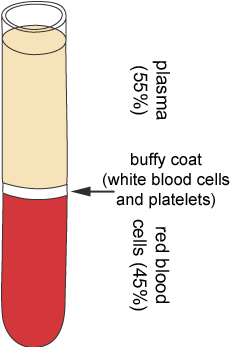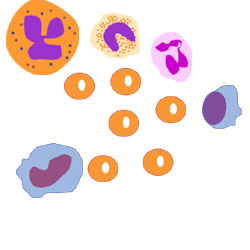Functions and Constituents

This is a diagram of a tube of blood, after spinning down in a centrifuge

This is a diagram of the various different types of red and white cells found in blood.
Functions of blood.
- Transports gases, nutrients, waste, cells and hormones throughout the body.
- Transports O2, CO2, nutrients, hormones, heat and wastes.
- Regulates pH, temperature, water content of cells.
- Protects against blood loss through clotting.
- Protects against disease through phagocytic white blood cells and antibodies.
- The process by which blood is made is called Haemopoiesis.
Blood Constituents
Blood consists of blood cells and plasma.
If blood is treated with an anticoagulant and centrifuged, the blood cells sediment leaving a supernatant of clear plasma.
Blood Cells
The sedimented blood cells account for 35-50% of the volume of blood and are of three basic types.
- erythrocytes or red blood cells
- leucocytes or white blood cells
- platelets or thrombocytes.
In normal whole blood there are about
- 5 - 10 x 106 erythrocytes per ml
- 1 - 5 x 103 leucocytes per ml
- 1.5 - 4 x 105 platelets per ml
Plasma
The plasma accounts for 55% of the blood volume. It consists of a solution of water (92%), proteins, lipids, inorganic ions (salts) and glucose. The proteins include hormones. The salts include urea, that are waste products of cells.
The proteins make up 6-7 % of blood and are made up mostly of serum albumin, and serum globulins. Serum albumin is made in the liver, and helps to maintain the osmotic pressure of blood. There are three types of serum globulins; alpha, beta and gamma. Alpha is involved in transporting vitamin A, beta in transporting transferrin, and most antibodies are gamma globulins.
Cholesterol is also found in the blood, in a mixture of high density and low density forms (HDL and LDL). High LDL levels are linked with atherosclerosis, where plaques can form on the inside of arteries. This can lead to cardiac disease and/or strokes. In contrast, high levels of HDL may protect against heart disease.